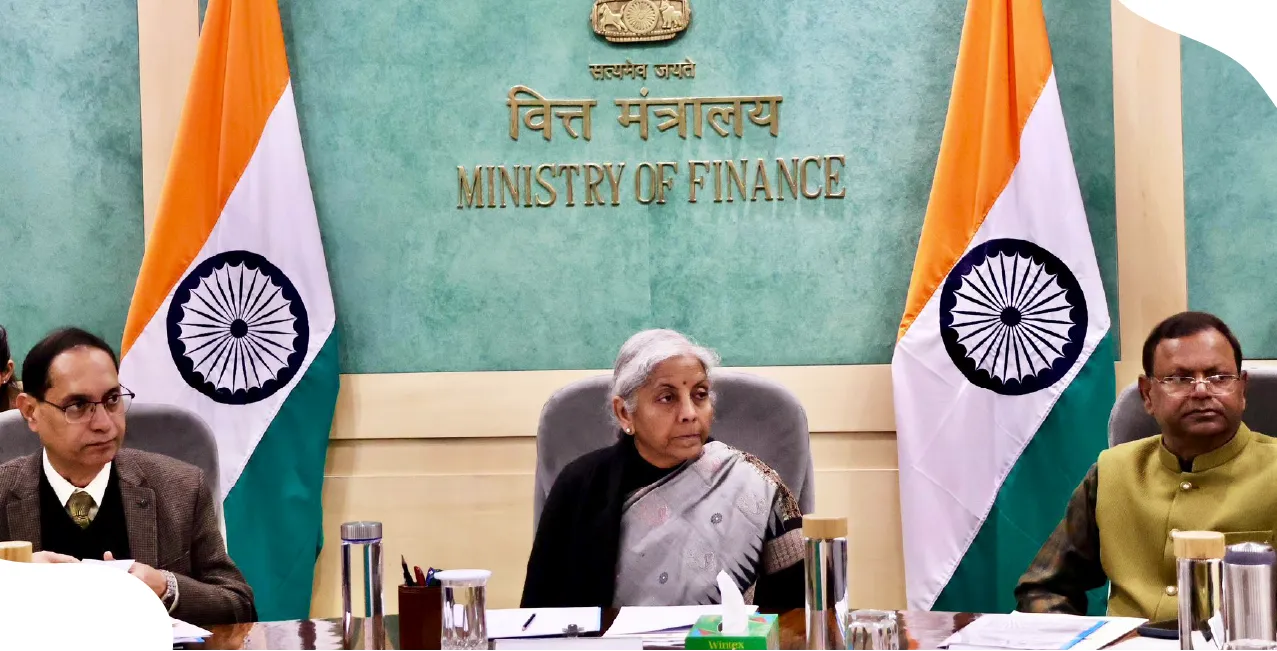
Author
LoansJagat Team
Read Time
4 Min
07 Aug 2025
Finance Ministry: World is witnessing trade policy dislocation
Half-Yearly Report Flags Uncertainty, Delays 3-Year Spending Plan
Can a government make long-term spending plans when the global economy is so uncertain? According to the Indian Finance Ministry, the answer is no, at least for now.
In a report submitted to Parliament on August 6, 2025, under the Fiscal Responsibility and Budget Management (FRBM) Act, 2003, the Finance Ministry announced that it has not released the Medium-Term Expenditure Framework (MTEF) in 2025.
The main reason for not releasing the MTEF report in 2025 is that the global economy is too unstable due to sudden changes in trade patterns and rising political tensions, making accurate planning very difficult.
Why the Government Changed 2025’s Spending Roadmap?
Trade policy dislocation means sudden and unexpected changes in global trade, often caused by big countries changing their trade rules or getting into disputes. The Finance Ministry explained that since the Budget was presented in February 2025, many global events have created a highly uncertain environment.
These include rising conflict in West Asia and the unpredictable trade decision of leaving 50% tarrifs by the United States. Such developments were not foreseen when the Budget was prepared.
Usually, the government makes medium-term spending plans assuming stable global trade. But with major trade routes facing delays and new tariffs creating tensions, those assumptions are no longer dependable.
Here are some key figures the ministry said it can’t rely on right now:
These estimates usually support the MTEF, which guides government spending for the next three years. But without dependable numbers to base it on, releasing the framework now would risk poor and unrealistic planning.
India’s Trade Faces New Global Challenges
Since the beginning of 2025, several unexpected events have made things harder for India’s trade. In April, the United States suddenly imposed a 25% tariff on some Indian exports, including automotive parts and electronics. This was a major blow to Indian exporters, especially small and mid-sized businesses.
The Ministry of External Affairs strongly criticised the decision, calling it “extremely unfortunate, unfair, unjustified and unreasonable.” The Finance Ministry also mentioned it in its recent report, saying that such shocks have seriously changed India’s financial plans.
To understand the impact, imagine a small electronics manufacturer in Bengaluru that had just signed a deal to export gadgets to the U.S. After the tariff announcement, the buyer backed out, saying the products would become too expensive. This kind of disruption has happened across many industries.
At the same time, global consumption is slowing down, especially in Europe and Southeast Asia, two major markets for India. As people in those regions cut back on spending, Indian exports like textiles, pharmaceuticals, and machinery have taken a hit.
Here's a quick look at what’s affecting India’s trade and how:
These ongoing problems shake the foundation of government income from trade. That means it becomes very hard to predict how much money will come in and nearly impossible to plan future spending with confidence.
IMF Growth Forecast: A Mixed Signal
Adding more pressure, the International Monetary Fund (IMF) lowered India’s expected economic growth for 2025–26. In April 2025, it cut the forecast from 6.5% to 6.2%, citing weak private spending and falling international trade.
Lower growth doesn’t just sound bad, it directly affects how much tax the government collects. When businesses sell less and people earn less, the government collects less income tax and customs duty. This shortfall hurts big plans for roads, healthcare, and social programs.
But there was some good news too. In July 2025, the IMF revised its growth forecast upward to 6.4%, saying that domestic demand had bounced back slightly and global trade was showing small signs of recovery.
Here’s how the forecasts changed:
While the newer forecast is a bit more hopeful, it’s still not quite at the level India expected earlier in 2025. Even a small drop of 0.1 to 0.3 percentage points in GDP can mean tens of thousands of crores less for the government, money that would have gone into building infrastructure, improving schools, or supporting the poor.
So, when the Finance Ministry decided not to release the MTEF in 2025, it wasn’t just skipping a routine update, it was facing the hard reality that guessing three years ahead in this economic climate could do more harm than good.
The absence of the MTEF thus becomes not just a procedural break, but a financial one.
Conclusion
The Finance Ministry’s mid-year report raises some important questions. Will the government bring back the MTEF once things become more stable? Can ministries like health, education, or transport continue to plan without a long-term budget roadmap? And most importantly, how will India manage its budget goals when it is collecting less money than expected?
For now, the government may have to take a more cautious route, making short-term spending plans, updating numbers every few months, and avoiding big promises that stretch too far into the future.
Until global trade becomes more stable and predictable again, it seems like playing it safe with money is the new normal for India’s financial planning.
Other News Pages | |||
Retail Mortgage Loans by NBFCs, HFCs to Hit ₹20 Trillion by FY28 | |||
About the Author

LoansJagat Team
‘Simplify Finance for Everyone.’ This is the common goal of our team, as we try to explain any topic with relatable examples. From personal to business finance, managing EMIs to becoming debt-free, we do extensive research on each and every parameter, so you don’t have to. Scroll up and have a look at what 15+ years of experience in the BFSI sector looks like.

Quick Apply Loan
Subscribe Now
Related Blog Post

LoansJagat Team • 10 Jun 2025

LoansJagat Team • 06 Jun 2025

LoansJagat Team • 22 Sep 2025